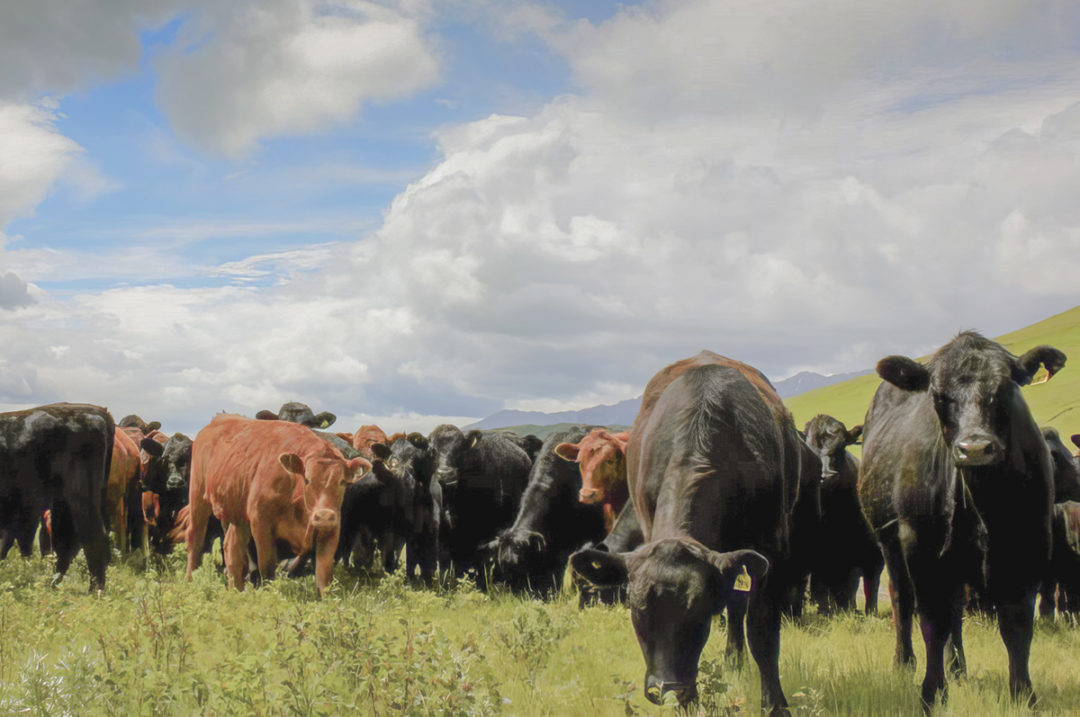The use of genomic tools will improve the sustainability of beef production by improving profitability, lowering the carbon footprint and improving an animal’s ability to adapt to changing environments. Historically, the relative value of traits to the commercial cow-calf sector has been stated as the “10-to-2-to-1 rule of thumb,” where fertility traits are 10 times more important than carcass traits and five times more important than growth traits (Figure 1).
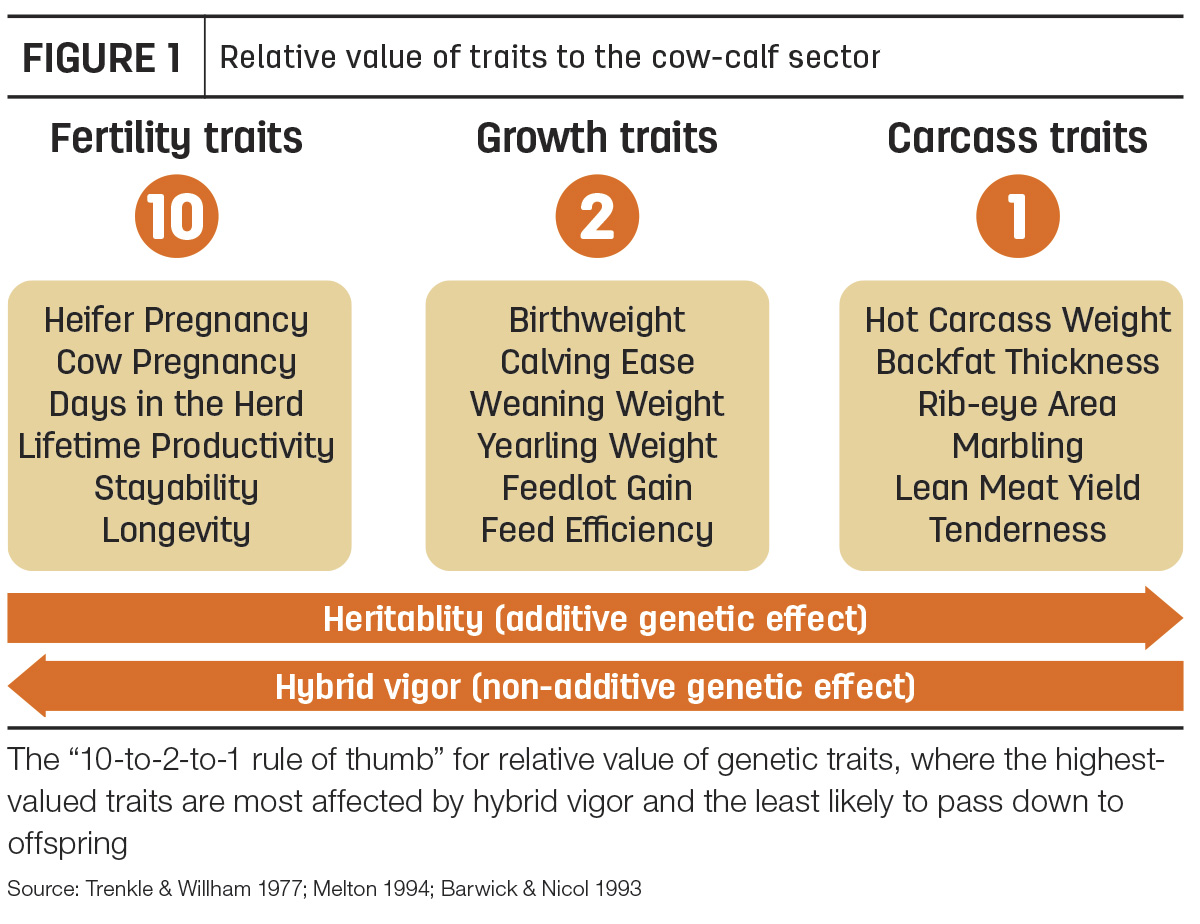
This simple organization of traits recognizes that heritability (the likelihood of offspring inheriting the traits of the parents) increases as we move from fertility (low) to growth and feed efficiency (moderate) to carcass (moderately high) traits. It also recognizes that, in a crossbreeding production system, fertility and health resilience traits are more influenced by nonadditive genetic effects (such as hybrid vigor), although additive genetic effects are still important for improving fertility and longevity. Genetic trends published by the American Angus Association clearly show that growth and carcass traits have increased dramatically over the past 50 years. In fact, yearling weight has increased at 3 pounds per year; at the same time, average daily feed intake (on a dry matter basis) has increased at a rate of 0.054 pounds per year.
Unfortunately, heifer pregnancy has remained relatively constant over the same period (Figure 2). Similarly, calf crop percentage in Canada and the U.S. has remained constant at 82% to 84% for more than 30 years, with 10% to 13% potential calves lost due to female infertility and a further 4% to 5% to perinatal deaths, despite major advances in nutrition and health management. This level of calf crop percentage does not indicate a “biological limit” but rather represents suboptimal management, a lack of breeding to improve hybrid vigor and ineffective selection indexes for fertility, longevity and lifetime productivity.
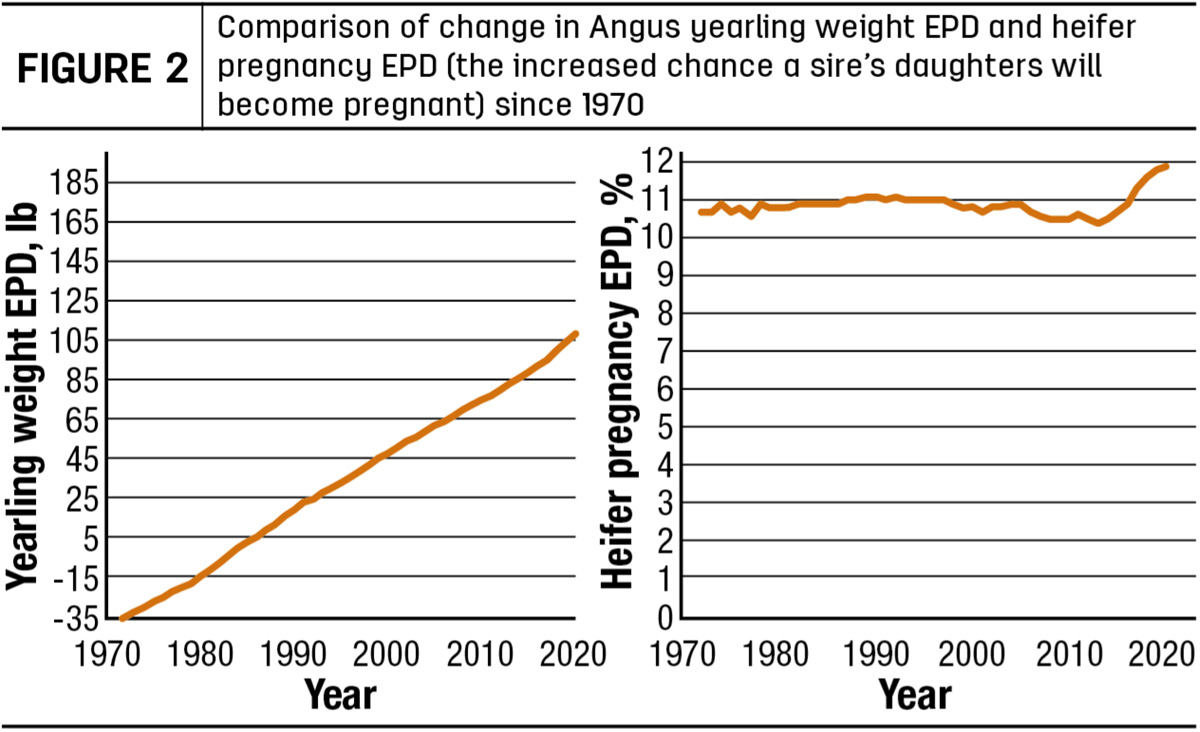
Researchers at Livestock Gentec, a collaboration of the University of Alberta (U of A) and Agriculture and Agri-Food Canada (AAFC), have created a large dataset of genetic and performance information from commercial crossbred cattle from western Canada. This dataset is focused on hard-to-measure, economically relevant traits, such as feed efficiency, carcass merit, female fertility and longevity, and has led to molecular breeding values for important traits with 35% to 60% accuracy. This accuracy is equivalent to 10 to 20 progeny records. With this dataset, Livestock Gentec has developed a suite of genomic prediction tools, including a multitrait selection score for replacement heifers that combines the nonadditive genetic effect of hybrid vigor with additive genetic traits for feed efficiency, growth, fertility and longevity. This tool also provides genomic prediction of breed composition for individual animals to aid in breeding decisions that increase the degree of crossbreeding and improve hybrid vigor.
Previous research in our group has shown that each 10% increase in hybrid vigor leads to an increase in pregnancy rate, weaning rate, weaning weight, days in the herd and lifetime productivity as well as a reduction in age at first calving (Figure 3). When comparing high-vigor versus low-vigor replacement heifers, high-vigor heifers had a 36% increase in lifetime productivity, leading to a net return of about $120 per female per year over five calvings. Despite the benefits of hybrid vigor, there has been a reduction in the degree of crossbreeding in commercial herds since the 1990s. We estimate that over 40% of cattle in Canada would benefit from a 30% increase in hybrid vigor.
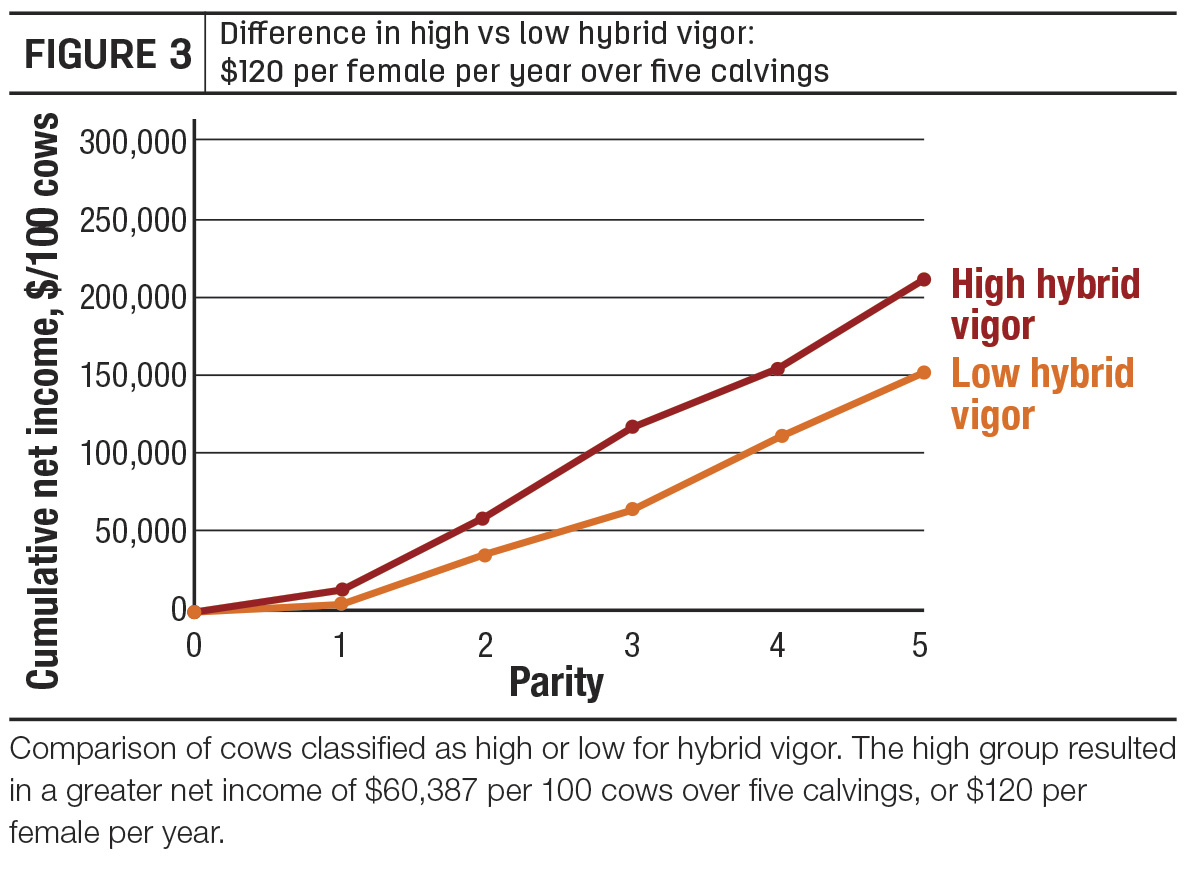
Livestock Gentec’s Replacement Heifer Profit Index (RHPI) score places 80% emphasis on a hybrid vigor score and 20% emphasis on seven traits associated with efficiency, growth, fertility and longevity, which are all economically weighted (Figure 4). The RHPI score was recently evaluated in 10 commercial herds in Alberta, using 908 crossbred heifers. Heifers with an above-average RHPI score had a lower open rate (13.7%) compared to below-average heifers (23.4%). Above-average scoring heifers produced nine more calves per 100 replacement heifers, which is worth $10,576 from increased weaned calf income when valued at $2.35 per pound for 500-pound calves. It is also worth an additional $6,379 ($709 per heifer) from not having to replace nine heifers, assuming a moderate 20% replacement rate. This would come at a cost of $2,238 to genotype 100 heifers ($22 per test), or a 6-to-1 return on investment. The cost of $709 per heifer accounts for all costs plus selling the cull replacement heifer. Other benefits may include improved health resilience of calves and a lower carbon footprint of beef production.
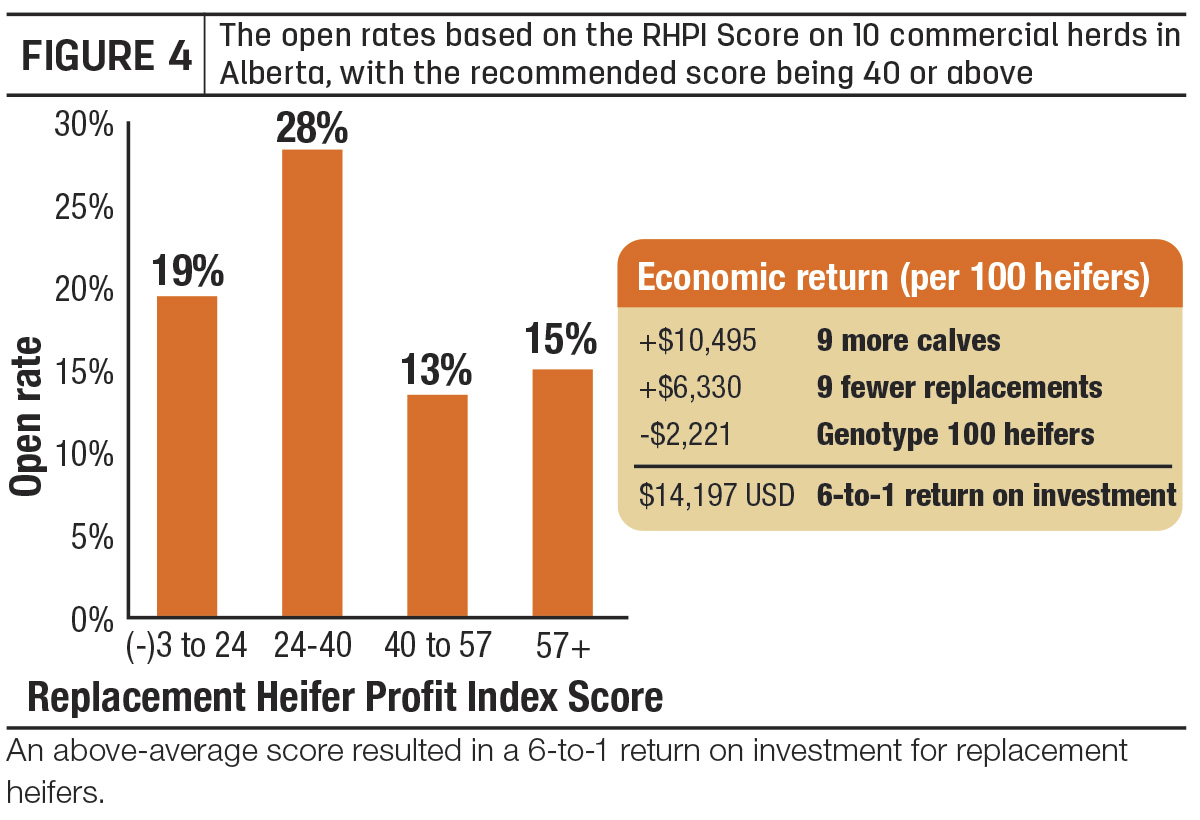
The RHPI score is an example of a genomic tool that can provide producers with more information on their animals, which will help make data-driven decisions. It can be added to traditional selection criteria to select superior replacements for:
- Early, easy, single births
- Soundness of conformation and structure
- Sixty percent of mature cow weight at breeding
- Cows with many daughters in the herd
- Ranking by RHPI score, with an ideal score being above 40
The index score can also help make breeding decisions to maintain or improve hybrid vigor by identifying genomic breed composition. One of the key takeaways of this work is the importance of hybrid vigor in an efficient, profitable and sustainable herd. While genomically testing each individual animal in your herd provides the most effective information, if that is not possible you can test only key animals (i.e., bulls and replacement heifers) or simply consider having two to three breeds of bulls that are used in rotation.
Livestock Gentec is also currently evaluating a new tool for pooling DNA samples from groups of animals to identify group- or herd-level hybrid vigor and genomic breed composition to aid in sire selection for the herd. As beef producers face more challenges to remain profitable and sustainable, genomic tools made for commercial cattle can provide the “unseen” data to help select superior animals that will achieve your production goals.
References omitted but are available upon request by sending an email to an editor.
